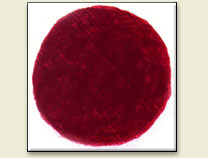A painted swatch of Madder lake (Alizarin):

History of Madder lake (Alizarin):
Madder red was another important synthetic pigment produced in the early years of the nineteenth century. This time, cost was not a factor in its development, but the need for a more permanent version of its ancient precursor. Dyes derived from the extract of the madder plant's root (rubia) were in use by the ancient Egyptians for coloring textiles. Bleached areas of natural madder can frequently be seen on fifteenth and sixteenth century paintings.
In the early nineteenth century, the natural madder dyestuff was developed as a pigment. Later in the century, a synthetic version was produced. In the mid-eighteenth century, most natural madder (Rubia tinctorum) was grown in Holland. England was importing all of the madder used in their textile production from Holland at a cost of three hundred thousand pounds per year.
In 1804, the Societé d'Encouragement des Artes awarded a medal to Sir Henry Englefield of England for a method of the preparation of madder lakes, dyestuffs that are attached to an inert substrate. This is a necessary process in order to grind such a pigment in oil. George Field had developed a press for extracting the dye that would filter and powder it. In an 1806 notebook, he noted his anger upon learning about the award because he had already been producing madder lake. He recorded his madder lake preparation in a notebook dated November 1808. One-half pound of alum (the inert substrate) was added to one-half pint of hot water and heated. He then added three-quarters of a pound of washed madder and heated the mixture for almost one hour. He strained the mixture, dried it on heat and let it set until it crystallized. He noted that it was "beautifully purple."
The madder lakes, which were prepared in a variety of shades from brownish to purplish to bluish reds were known to have superior permanence than the unlaked madders. It was a good glazing color that spread well in oil and was also prepared as a watercolor.
In 1826, the French chemists Colin and Robiquet first isolated the coloring principle from the madder plant and published their findings in Annales de Chimie XXXIV, "Recherches sur la matière colorante de la garance" in 1827. In the madder root, there are two coloring agents. One is the permanent alizarin and the other rapidly fading purpurin. It was the alizarin component that was made synthetically by the German chemists C. Graebe and C. Lieberman in 1868 and patented in England the same year. The synthesis caused the rapid decline and almost total disappearance of the madder-growing industry. As in the natural madder lake aluminum hydrate (alum) is used as a substrate for the synthetic variety, most commonly known as alizarin crimson.
Although alizarin crimson had superior permanence over the madder lake because of the absence of purpurin, both madder lakes were used in oil and watercolor painting. Some painters complained that the synthetic variety was less saturated and brilliant than madder. Both varieties were non-toxic, slow drying in oil and the deeper shades were more lightfast than the lighter ones. Both were compatible with all other pigments.
When was Madder lake (Alizarin) used?
| Discovery | Used until |
|---|---|
| natural: c. 1500 B.C. | continues in use |
Use of Madder lake (Alizarin) among paintings in the SchackGallery, Munich:

Source: Kühn

